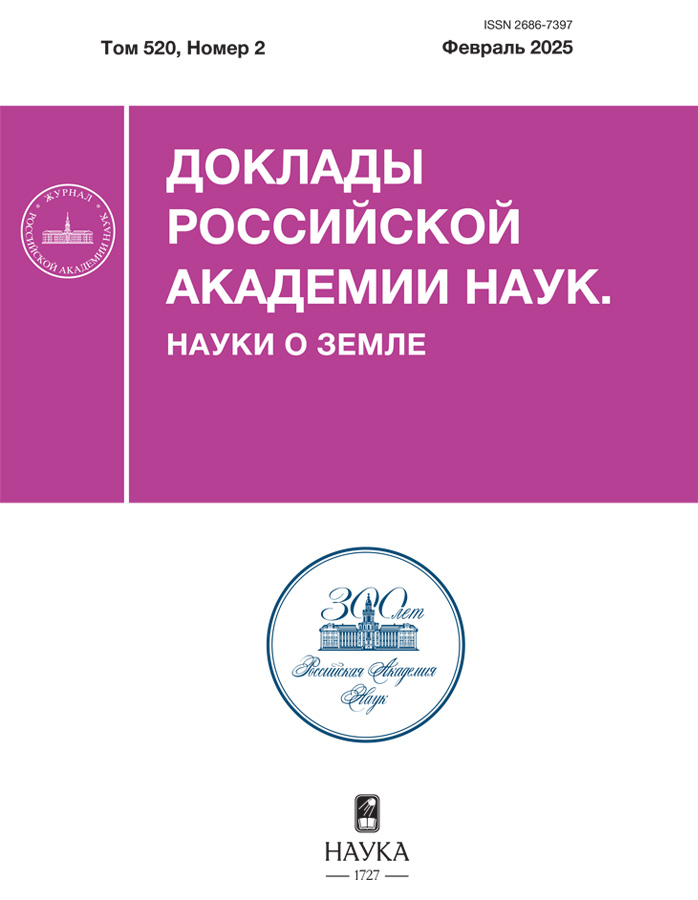Первые данные о возрасте и геодинамических условиях формирования кварцевожильного оруденения золото-сульфидно-теллуридного минерального типа на Среднем Урале
- Авторы: Смирнов В.Н.1, Мурзин В.В.1, Ерохин Ю.В.1, Пучков В.Н.1, Иванов К.С.1, Захаров А.В.1
-
Учреждения:
- Институт геологии и геохимии им. акад. А.Н. Заварицкого Уральского отделения Российской Академии наук
- Выпуск: Том 520, № 2 (2025)
- Страницы: 239-247
- Раздел: МЕТАЛЛОГЕНИЯ
- Статья получена: 18.06.2025
- Статья одобрена: 18.06.2025
- Статья опубликована: 04.09.2025
- URL: https://bulletin.ssaa.ru/2686-7397/article/view/685094
- DOI: https://doi.org/10.31857/S2686739725020079
- EDN: https://elibrary.ru/GDNXPA
- ID: 685094
Цитировать
Полный текст
Аннотация
Впервые датированы гранитоиды, с которыми связано кварцевожильное оруденение золото-сульфидно-теллуридного минерального типа на Среднем Урале. Объект исследования – альбитизированные гранит-порфиры Быньговского штока, к эндо- и экзоконтактовой зонам которого приурочены кварцевые жилы и околорудные метасоматиты березит-лиственитовой формации одноименного месторождения. В составе кварцевых жил широко распространено как самородное золото, так и теллуриды Au, Ag, Bi, Hg, Cu и других металлов. Возраст наименее измененных пород Быньговского штока – 394.7±3.1 млн лет (конец эмсского века раннего девона) определен U‒Pb-методом по зернам циркона (SHRIMP-II, Центр изотопных исследований ВСЕГЕИ). Полученные данные свидетельствуют о том, что образование гранитов Быньговского штока, как и комагматичных им вмещающих вулканитов, было связано с девонским этапом островодужного магматизма, протекавшим на территории восточного сектора Среднего Урала со второй половины эмса до середины франского века. По времени и геодинамическим условиям образования кварцевожильное оруденение золото-сульфидно-теллуридного минерального типа отличается от золотоносных кварцевых жил золото-сульфидного типа, для которых теллуридные формы металлов не характерны. Образование оруденения последнего типа на Среднем Урале происходило по имеющимся данным от 315 до 300 млн лет назад, что соответствует ранним эпизодам коллизионного магматизма. Повышенные концентрации теллура в постмагматических рудоносных флюидах, генерировавшихся в островодужных геодинамических условиях, скорее всего, обусловлено сопряженностью генерации гранитоидных и одновозрастных им расплавов основного состава с повышенными содержаниями теллура.
Ключевые слова
Полный текст
Об авторах
В. Н. Смирнов
Институт геологии и геохимии им. акад. А.Н. Заварицкого Уральского отделения Российской Академии наук
Автор, ответственный за переписку.
Email: smirnov@igg.uran.ru
Россия, Екатеринбург
В. В. Мурзин
Институт геологии и геохимии им. акад. А.Н. Заварицкого Уральского отделения Российской Академии наук
Email: smirnov@igg.uran.ru
Россия, Екатеринбург
Ю. В. Ерохин
Институт геологии и геохимии им. акад. А.Н. Заварицкого Уральского отделения Российской Академии наук
Email: smirnov@igg.uran.ru
Россия, Екатеринбург
В. Н. Пучков
Институт геологии и геохимии им. акад. А.Н. Заварицкого Уральского отделения Российской Академии наук
Email: smirnov@igg.uran.ru
член-корреспондент РАН
Россия, ЕкатеринбургК. С. Иванов
Институт геологии и геохимии им. акад. А.Н. Заварицкого Уральского отделения Российской Академии наук
Email: smirnov@igg.uran.ru
Россия, Екатеринбург
А. В. Захаров
Институт геологии и геохимии им. акад. А.Н. Заварицкого Уральского отделения Российской Академии наук
Email: smirnov@igg.uran.ru
Россия, Екатеринбург
Список литературы
- Сазонов В.Н. Золотопродуктивные метасоматические формации подвижных поясов. Екатеринбург: ИГГ УрО РАН, 1998. 181 с.
- Тимофеевский Д.А. О формационной классификации, минеральных типах и золотоносных минеральных ассоциациях золоторудных месторождений СССР // Труды ЦНИГРИ. 1971. Ч. 1. Вып. 96. С. 5–32.
- Мурзин В.В., Смирнов В.Н., Сазонов В.Н., Ведерников В.В. Минералогические особенности золотого оруденения, связанного с магматизмом габбро-гранитоидного и тоналит-гранодиоритового типов (на примере Петрокаменско-Верхотурской структурно-формационной зоны, Средний Урал) // Известия Уральской государственной горно-геологической академии. 1996. № 5. С. 45–48.
- Смирнов В.Н., Ферштатер Г.Б., Иванов К.С. Схема тектоно-магматического районирования территории восточного склона Среднего Урала // Литосфера. 2003. № 2. С. 45–56.
- Рудные месторождения и физические поля Урала / Е.М. Ананьева, К.К. Золоев, Р.И. Лутков, Л.Н. Овчинников, Б.А. Попов, М.С. Рапопорт, В.М. Рыбалка. Екатеринбург: УрО РАН, 1996. 295 с.
- Смирнов В.Н. Основные этапы магматизма восточного склона Среднего Урала // Литосфера. 2012. № 5. С. 4–15.
- Ведерников В.В. О возрасте вмещающих пород Быньговского месторождения // Ежегодник-1981. Институт геологии и геохимии УНЦ АН СССР. Свердловск: УНЦ АН СССР, 1982. С. 121–122.
- Государственная геологическая карта Российской Федерации. Масштаб 1 : 1 000 000 (третье поколение). Серия Уральская. Лист О-41 – Екатеринбург. Объяснительная записка. СПб.: Картфабрика ВСЕГЕИ, 2011. 492 с.
- Рапопорт М.С. Гранитоидный магматизм и золотое оруденение Среднего Урала // Уральская летняя минералогическая школа-96 / Материалы Всероссийской научной конференции студентов, аспирантов, научных сотрудников и преподавателей ВУЗов. Екатеринбург: УГГГА, 1996. С. 7–10.
- Берзон Р.О. Быньговское месторождение золото-сульфидно-кварцевой рудной формации (Урал) // Геология рудных месторождений. 1995. Т. 37. № 5. С. 417–426.
- Williams I.S. U-Th-Pb geochronology by ion microprobe // Reviews in Economic Geology. 1998. No. 7. P. 1–35.
- Ludwig K.R. On the treatment of concordant uranium leads // Geochim. Cosmochim. Acta. 1998. V. 62. № 4. P. 665–667.
- Зинькова Е.А., Холоднов В.В., Ферштатер Г.Б. U-Pb-цирконовый возраст золотоносного Середовинского массива (Средний Урал) // ДАН. 2008. Т. 420. № 4. С. 520–523.
- Смирнов В.Н., Иванов К.С., Шокальский С.П., Падерин И.П. Результаты U-Pb-датирования цирконов из гранитоидов Верхисетского и Краснопольского массивов (восточный склон Среднего Урала) // Региональная геология и металлогения. 2011. № 48. С. 50–59.
- Смирнов В.Н., Иванов К.С., Ларионов А.Н. Возраст и геодинамические условия формирования Верхисетского батолита, восточный склон Среднего Урала (по результатам U-Pb SIMS-датирования цирконов) // Стратиграфия. Геологическая корреляция. 2014. Т. 22. № 6. С. 26‒44. https://doi.org/10.7868/S0869592X14060052
- Прибавкин С.В., Пушкарев Е.В. Возраст поздних орогенных гранитоидов Урала по данным U-Pb-изотопии цирконов (на примере Шарташского и Шабровского массивов) // ДАН. 2011. Т. 438. № 3. С. 369‒373.
- Прибавкин С.В., Монтеро П., Беа Ф., Ферштатер Г.Б. U-Pb возраст и состав пород Берёзовского рудного поля (Средний Урал) // Литосфера. 2013. № 1. С. 136‒145.
- Вотяков С.Л., Прибавкин С.В., Замятин Д.А. Химическое датирование циркона из гранитных пегматитов Шарташского массива (Средний Урал) // ДАН. 2016. Т. 470. № 1. С. 83‒86. https://doi.org/10.7868/S0869565216250228
- Смирнов В.Н., Иванов К.С., Коровко А.В. Результаты U-Pb SIMS датирования коллизионных гранодиорит-гранитных массивов Восточной зоны Среднего Урала // Региональная геология и металлогения, 2021. № 86. С. 23‒30. https://doi.org/10.52349/0869-7892_2021_86_23-30
- Иванов В.В. Экологическая геохимия элементов. Кн. 3. М.: Недра, 1996. 353 с.
Дополнительные файлы















